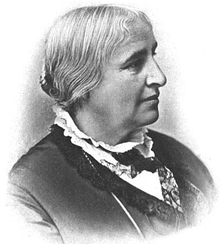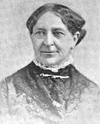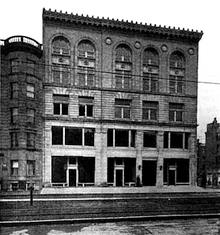New England Women's Club
The New England Women's Club (est.1868) of Boston, Massachusetts, was the "first woman's club" in the United States.[1] Harriet Hanson Robinson, founder of the National Woman Suffrage Association of Massachusetts, helped Julia Ward Howe to organize the club.[2] Members of the club in its early years included Ednah Dow Littlehale Cheney, Mary Livermore, Lucretia Mott, Elizabeth Peabody, Lucretia Peabody, Caroline M. Severance,[1][3] and Lucy Stone.[4][5][6]
History

In 1868 "club rooms were first secured in ... the rear of the popular Tremont House. On May 30, 1868, the first meeting to introduce the New England Woman's Club to the public was held in Chickering Hall. At this meeting such able friends and advisers as Ralph Waldo Emerson, James Freeman Clarke, Jacob Manning, John Weiss, O.B. Frothingham, Thomas Wentworth Higginson, Bronson Alcott, Julia W. Howe and Mrs. E.D. Cheney were the speakers."[1] In its first year, club members set about organizing a horticultural school.[7]

Around the 1870s in Boston there existed a few other clubs "patronized by ladies, viz: ... the Saturday Morning Club, the Brains Club and the Young Ladies Club, the members of which are in general high-toned persons, interested in intellectual and philanthropic matters -- no cigars, no champagne and no 'draw,' except in the tea-pot."[8]
The club incorporated in 1887; Sarah H. Bradford, Ednah D. Cheney, Lucy Goddard, Abby W. May, L.M. Peabody, Harriet M. Pittman, H.W. Sewall, and Kate Gannett Wells served as signatories. "The object of this association shall be to provide a suitable place of meeting in Boston for the convenience of its members, and to promote social enjoyment and general improvement." Committees oversaw club activities with regards to "Art and Literature;" "Discussions;" "Education;" and "Work." "Monday Teas" were held every week.[9] "The new association was officered and controlled by women, although during the first quarter century there were a very few men enrolled -- names like the Rev. James Freeman Clarke, Ralph Waldo Emerson, and Thomas Wentworth Higginson."[4] By 1893 some 340 members belonged to the club.[5]
Lectures occurred frequently, given by both club members and invited speakers. Among the many lecturers in the club's first decades were:[5] Louis Agassiz, Amos Bronson Alcott, George Thorndike Angell, Richard Henry Dana, Jr., Ralph Waldo Emerson, Annie Adams Fields, James T. Fields, William Lloyd Garrison, Edward Everett Hale, Thomas Wentworth Higginson, Oliver Wendell Holmes, Sr., Henry James, and Mary Tyler Peabody Mann.
Around 1903 the club moved its headquarters from Park Street to the newly constructed "New Century Building" on Huntington Avenue, designed by architect Josephine Wright Chapman.[10]
References

- 1 2 3 Ella Giles Ruddy, ed. The mother of clubs: Caroline M. Seymour Severance: an estimate and an appreciation. Baumgardt Pub. Co., 1906
- ↑ Emerson, Dorothy May; Edwards, June; Knox, Helene (2000). Standing Before Us: Unitarian Universalist Women and Social Reform, 1776-1936. Unitarian Universalist Association of Congregations. p. 82. ISBN 978-1-55896-380-1. Retrieved 2012-07-02.
- ↑ Mother of Women's Clubs Dead. New York Times, November 11, 1914.
- 1 2 Helen M. Winslow. The story of the woman's club movement. New England Magazine, July 1908.
- 1 2 3 Julia A. Sprague. History of the New England Women's Club from 1868 to 1893. Boston: Lee & Shepard, 1894
- ↑ Daily Inter Ocean (Chicago); Date: 04-20-1889
- ↑ New England Woman's Club Anniversary. New York Herald; Date: 05-30-1869
- ↑ Georgia Weekly Telegraph; Date: 02-09-1875
- ↑ New England Women's Club. Act of Incorporation. 1887.
- ↑ Helen M. Winslow. The Boston Women's Club House. Delineator, 1903.
Further reading
- C.P. Cranch. Ode; read at the festival celebrating the birthday of Margaret Fuller Ossoli, held by the New England Women's club, Boston, May 23, 1870. Atlantic Monthly, Aug. 1870.
- J.C. Croly. "New England Woman's Club." The history of the woman's club movement in America. NY: H. G. Allen & Co., 1898; p. 35+ Published under the authority of the General Federation of Women's Clubs
- Ednah Dow Cheney, 1824-1904: memorial meeting, New England Women's Club, Boston, February 20, 1905. Boston: Geo. H. Ellis Co., printers, 1905.
External links
| Wikimedia Commons has media related to New England Women's Club. |
- Harvard University New England Women's Club. Records, 1843-1970: A Finding Aid.
- Boston Athenaeum. Dickens party at the New England Woman’s Club, 1905; photo by Elmer Chickering. "Group portrait taken at a party at which club members dressed in costume as characters from the novels of Charles Dickens. Handwritten key on verso identifies three of the members as Mrs. Julia Ward Howe, the hostess, who founded the club in 1868; Mrs. Daniel Lothrop dressed as Betsey Trotwood; and Mrs. Leo Hunter."